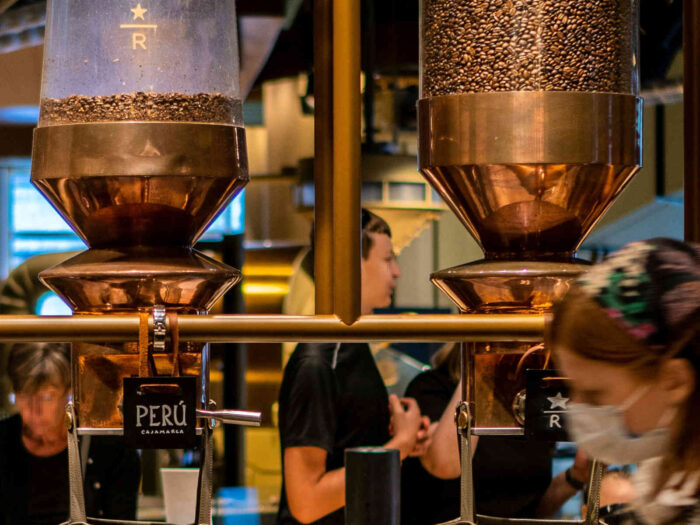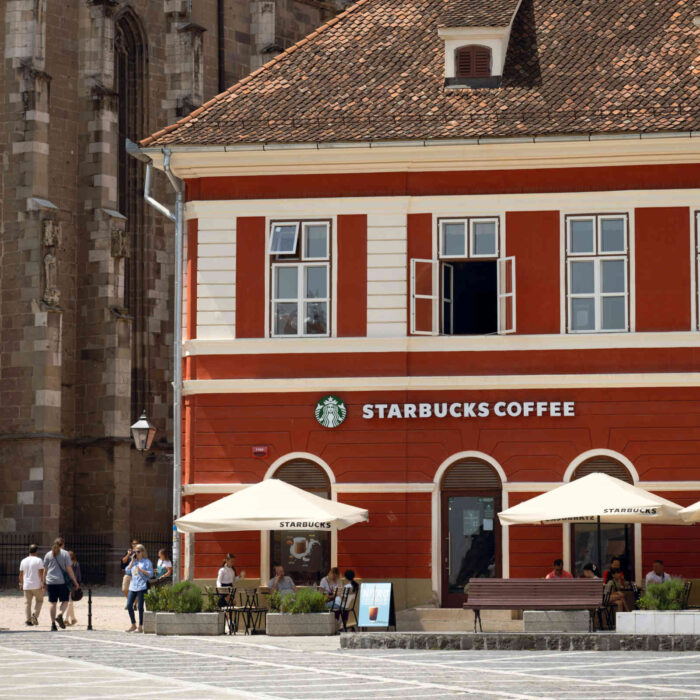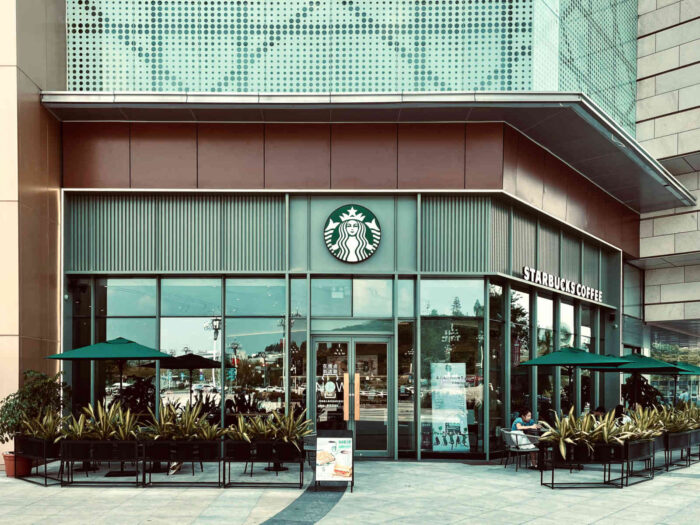
This Five Forces analysis of Starbucks Corporation, using Porter’s model, illustrates business effectiveness in strategically managing the impacts of the five forces in the global coffeehouse industry environment. With Michael E. Porter’s Five Forces analysis model, Starbucks’ industry environment is evaluated based on external factors defining the competitive landscape.
This external analysis provides information for the coffee company’s strategic management to address the five forces (competitive rivalry, bargaining power of customers or buyers, bargaining power of suppliers, threat of substitution, threat of new entrants).
Starbucks’ business environment involves strong competition. The SWOT analysis of Starbucks shows strengths for countering the competitive forces described in this Five Forces analysis.
This Five Forces analysis of Starbucks highlights external factors shaping strategies. These strategies focus on competitive advantages to fulfill Starbucks’ mission and vision and maintain the company’s industry dominance.
Competition or Competitive Rivalry (Strong Force)
Starbucks Coffee Company faces the strong force of competitive rivalry. In the Five Forces analysis model, this force pertains to the influence of competitors on each other and the coffeehouse industry environment. In this case, the following external factors contribute to the strong force of competition against Starbucks:
- Large number of coffeehouses and foodservice firms (strong force)
- Moderate variety of businesses (moderate force)
- Consumers’ low switching costs between coffeehouses (strong force)
The large number of coffeehouses and foodservice firms is an external factor that intensifies competitive rivalry in the context of this Five Forces analysis. Starbucks has many competitors of different sizes, including multinational businesses and small local cafés.
The company’s main competitors include coffeehouses, like Tim Hortons, and foodservice businesses, like Dunkin’, McDonald’s, Wendy’s, Burger King, and Subway. Many of these foodservice companies offer lower-priced drinks, including coffee.
Also, competitors are moderately varied in terms of specialty and strategy. For example, some coffeehouses focus on local coffee varieties only. In this Five Forces analysis of Starbucks, moderate variety strengthens competition by dividing the market into segments based on business specialty or strategy.
Moreover, competition is strengthened because of consumers’ low switching costs between coffeehouses. In the Five Forces analysis model, low switching costs reduce barriers when customers switch from Starbucks to competitors.
Based on this component of the Five Forces analysis, competition is among the coffee company’s top-priority challenges. Starbucks’ generic competitive strategy and intensive growth strategies reflect strategic responses to such competitive challenges.

Bargaining Power of Customers or Buyers (Strong Force)
Starbucks experiences the strong force or bargaining power of buyers or customers. In Porter’s Five Forces analysis model, this power is based on the influence of individual customers and their groups on the coffeehouse business environment. The following external factors contribute to the strong bargaining power of customers relative to Starbucks:
- Low switching costs between coffeehouses and other providers (strong force)
- High availability of substitute foods and beverages (strong force)
- Small size of individual buyers (weak force)
The bargaining power of consumers or buyers is among the most significant forces affecting the coffeehouse industry determined in this Five Forces analysis. With low switching costs, customers can easily transfer from Starbucks to other brands.
In addition, the high availability of substitutes means that customers can easily stay away from Starbucks’ products and opt for substitutes, like instant beverages from vending machines, home-brewed coffee, and other drinks from local cafés.
These strong external factors overshadow the fact that individual purchases are small compared to Starbucks’ total revenues. In the Five Forces analysis context, small individual purchases mean that individual consumers have weak or insignificant influence on the business. However, low switching costs and high substitute availability lead to the overall strong force of the bargaining power of customers against Starbucks.
Such a strong force in this component of the Five Forces analysis shows that the bargaining power of customers is a top-priority strategic issue. Starbucks’ marketing mix or 4P can support brand strengthening to partially address the bargaining power of buyers/consumers.
Bargaining Power of Starbucks’ Suppliers (Moderate Force)
Starbucks Coffee Company faces the moderate force or bargaining power of suppliers. Porter’s Five Forces analysis model considers this power as the influence that suppliers have on the coffeehouse chain business and its industry environment. The following external factors contribute to suppliers’ moderate bargaining power over Starbucks Corporation:
- Moderate size of individual suppliers (moderate force)
- Limited variety of suppliers (moderate force)
- Supply shortages (strong force)
The moderate size of individual suppliers is an external factor that imposes a moderate force on Starbucks. In the Five Forces analysis framework, larger suppliers have stronger bargaining power over the coffee business.
On the other hand, the limited variety of suppliers provides them with only moderate bargaining power relative to Starbucks. For example, different suppliers may have similar supplies if they source their coffee beans from the same region or country. In the Five Forces analysis model, this condition enables Starbucks to shift from one supplier to another with moderate ease because of these suppliers’ similarities.
The bargaining power of coffee suppliers is partially strengthened because of supply shortages. Such shortages are linked to droughts that damage crops, among the other ecological concerns presented in the PESTLE/PESTEL analysis of Starbucks.
Shortages enable suppliers to impose their demands, such as by increasing the prices of coffee beans, thereby strengthening their bargaining power in the context of this Five Forces analysis of Starbucks.
Overall, the external factors enumerated in this section of the Five Forces analysis create the moderate force of suppliers in Starbucks’ business environment. Suppliers are a considerable influence in the coffeehouse chain’s competitive environment.

Threat of Substitutes or Substitution (Strong Force)
The strong force or threat of substitution affects Starbucks Corporation. In the Five Forces analysis model, this threat pertains to the impact of substitute goods or services on the coffee business and its external environment. The following external factors contribute to the strong threat of substitution against Starbucks:
- High availability of substitute foods and beverages (strong force)
- Low switching costs between coffeehouses and substitutes (strong force)
- High affordability of substitute products (strong force)
This component of the Five Forces analysis of Starbucks indicates that substitutes have strong potential to negatively impact the coffeehouse chain business. The high availability of substitutes makes it easy for consumers to buy these substitutes instead of Starbucks’ products.
There are many substitutes, such as ready-to-drink beverages, instant beverage powders and purees, and foods and drinks available from various outlets. These outlets include fine-dining restaurants, vending machines, supermarkets and grocery stores, and small convenience stores.
In the Five Forces analysis framework, this high availability of substitute products is an external factor that strengthens the competitive force of substitution against Starbucks’ products and coffeehouses.
In addition, the low switching costs further strengthen the threat of substitutes to coffeehouse products. This external factor is viewed in the Five Forces analysis as an enabler of consumers in switching from Starbucks to substitutes.
Moreover, many of these substitutes are more affordable than Starbucks’ foods and beverages. This affordability factor helps strengthen the threat of substitution against the multinational coffeehouse chain.
Starbucks’ organizational culture (business culture) helps address the threat of substitutes by ensuring, through human resources and workplace behaviors, high-quality service that reinforces customer loyalty.
Also, Starbucks’ CSR, ESG, and stakeholder management initiatives can help retain customers based on emphasis on sustainable business practices and corporate citizenship that enhances brand value.
Threat of New Entry/New Entrants against Starbucks (Moderate Force)
The moderate force or threat of new entry imposes challenges to Starbucks Corporation. In Porter’s Five Forces analysis model, this threat refers to the effect of new players or new entrants in the coffeehouse industry. In this business case, the following external factors contribute to new entrants’ moderate threat to Starbucks:
- Moderate cost of doing business (moderate force)
- Moderate supply chain costs (moderate force)
- High cost of brand development (weak force)
The moderate cost of doing business refers to the cost of establishing and maintaining operations in the coffeehouse industry. For example, the cost of operating a small local coffeehouse is lower compared to that of a Starbucks coffeehouse. Also, smaller cafés have lower supply needs and corresponding supply chain costs.
Despite their relatively small sizes, the presence of many new entrants can reduce Starbucks’ market share and revenues. Thus, in this Five Forces analysis, these two external factors lead to the moderate threat of new entrants in the coffeehouse industry.
The high cost of brand development is viewed in the Five Forces analysis framework as an external factor that limits the threat of substitution against Starbucks Corporation. Small local coffeehouses typically do not have the resources to develop their brands to directly compete with the Starbucks brand. Also, brand development takes years to reach the level and strength of the Starbucks brand.
The external factors enumerated in this part of the Five Forces analysis establish the threat of substitutes as a moderate force and, thus, a significant but limited issue in the multinational coffeehouse chain’s strategic management decisions.

Summary: Five Forces Analysis of Starbucks
Considering external factors in the coffeehouse industry and coffee markets, the following are the intensities of the forces established in this Five Forces analysis of Starbucks Coffee Company:
- Competitive rivalry or competition – Strong Force
- Bargaining power of buyers or customers – Strong Force
- Bargaining power of suppliers – Moderate Force
- Threat of substitutes or substitution – Strong Force
- Threat of new entrants or new entry – Moderate Force
The strong force of competition is the combined effect of the external factors identified in this Five Forces analysis of the coffeehouse industry environment. The most significant forces for Starbucks’ strategic consideration are competitive rivalry, the bargaining power of customers, and the threat of substitutes. The other forces also influence competitive dynamics and Starbucks Coffee Company’s business performance, but to a lesser degree.
Recommendations – Five Forces Analysis of Starbucks
In this Five Forces analysis case, business strengths and competencies and the business threats facing the coffeehouse chain and its products justify the following recommendations for Starbucks:
Recommendation 1. Implement strategies to make the Starbucks brand even stronger in the coffeehouse business environment. This recommendation addresses the forces of competitive rivalry, buyer power, and substitution threat against Starbucks.
Recommendation 2. Boost Starbucks’ coffeehouse chain’s competitive advantages, such as by improving the diversity of its supply chain to enhance access to resources and the stability of the company’s coffee processing and production.
This recommendation targets the force of competition depicted in this Five Forces analysis of the coffee business. Changes in the supplier network may require related changes in Starbucks’ operations management strategies.
Recommendation 3. Increase the coffee company’s marketing aggressiveness to attract and retain more customers. This recommendation aims to manage the forces of substitution, competition, and new entry in this Five Forces analysis of Starbucks.
References
- About Starbucks Coffee Company.
- Mahardika, R. P., Ismoyowati, D., & Ushada, M. (2025). Green marketing in the coffee shop: Gen Z repurchase intention through customer satisfaction. In BIO Web of Conferences (Vol. 167, p. 07004). EDP Sciences.
- Pangarkar, N., & Prabhudesai, R. (2024). Using Porter’s Five Forces analysis to drive strategy. Global Business and Organizational Excellence, 43(5), 24-34.
- Starbucks Corporation Form 10-K.
- Starbucks Corporation Supplier Diversity Program.
- U.S. Department of Agriculture – Economic Research Service – Food Service Industry Market Segments.
- Zhang, B., & Ip, W. S. C. (2025). Starbucks’ critical success factors based on customer perception. Highlights in Business, Economics and Management, 49, 104-119.